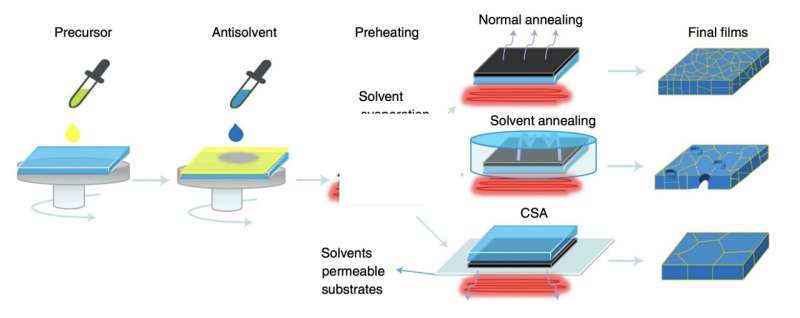August 23, 2022 feature
A strategy to improve perovskite absorbers for all-perovskite tandem solar cells

Tandem solar cells (TSCs), stacks of p-n junctions based on semiconductors with different bandgaps, are a highly promising energy solution that could help to reduce carbon emissions. Perovskites, earth-abundant materials with a tunable bandgap, high charge-carrier mobilities, advantageous optoelectronic properties and long carrier diffusion lengths, could be particularly valuable for creating low-cost and highly power-efficient TSCs for large-scale implementations.
To fabricate efficient all-perovskite TSCs, engineers need to be able to grow high-quality and uniform perovskite absorbers through crystallization processes. Absorbers are semiconducting layers inside solar cells that absorb photons (i.e., light particles) and excite electrons to create photocurrent from sunlight. So far, however, a universal and effective process to prepare perovskite absorbers for TSCs is still lacking.
Researchers at Soochow University and Sichuan University have recently devised a new strategy to create high-quality perovskite absorbers with grains in the micrometer scale and prolonged carrier lifetimes. This strategy, introduced in a paper published in Nature Energy, is based on a close-space annealing (CSA) process, a heat-based technique that can be used to change a material's chemical properties.
"Controllable crystallization plays a crucial role in the formation of high-quality perovskites," Changlei Wang and his colleagues wrote in their paper. "Here, we report a universal CSA strategy that increases grain size, enhances crystallinity and prolongs carrier lifetimes in low-bandgap (low-Eg) and wide-bandgap (wide-Eg) perovskite films."
Remarkably, the CSA strategy devised by Wang and his colleagues is universal, as it can be applied to perovskites with various bandgaps to produce high-quality absorbers with enlarged grains and longer carrier lifetimes. As part of their recent study, the team demonstrated its generalizability by successfully using it to prepare absorbers based on perovskites with different chemical compositions.
Essentially, the newly presented strategy entails growing perovskites through the CSA process, while managing the presence of residual solvents inside the intermediate-phase perovskites (i.e., the perovskite's form before the final annealing steps take place). The researchers found that this promoted the growth of grains, merging neighboring crystals as solvents were slowly released from the perovskites.
"By placing the intermediate-phase perovskite films with their faces towards solvent-permeable covers during the annealing process, high-quality perovskite absorber layers are obtained with a slowed solvent releasing process, enabling fabrication of efficient single-junction perovskite solar cells (PVSCs) and all-perovskite tandem solar cells," Wang and his colleagues explained in their paper.
In initial evaluations, the CSA strategy devised by the researchers enabled the creation of highly performing perovskite absorbers with both low and wide bandgaps. These absorbers were then used to fabricate 4-T and 2-T all-perovskite TSCs that exhibited remarkable power conversion efficiencies.
"The best PCEs of 21.51% and 18.58% for single-junction low-Eg and wide-Eg PVSCs are achieved and thus ensure the fabrication of 25.15% efficiency 4-terminal and 25.05% efficiency 2-terminal all-perovskite tandem solar cells," Wang and his colleagues wrote in their paper.
In the future, the CSA strategy introduced by this team of researchers could be used to create better absorbers for low-cost and efficient TSCs that are solely based on perovskites. This could facilitate the large-scale implementation of these highly promising energy solutions. Meanwhile, their study could also inspire other research teams worldwide to devise similar fabrication strategies for producing highly performing perovskite absorbers.
More information: A universal close-space annealing strategy towards high-quality perovskite absorbers enabling efficient all-perovskite tandem solar cells. Nature Energy(2022). DOI: 10.1038/s41560-022-01076-9.
© 2022 Science X Network

















